IDP News Issue No. 18
The Travels of the Three Rabbits: Shared Iconography Across the Silk Road
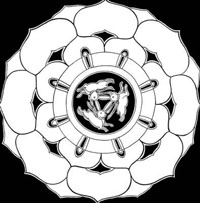

Left:Representation of the ceiling apex in Cave 407, Dunhuang, China, dated to the Sui dynasty (589-618). Drawing by Ouyang Lin
Right:A modern glass panel copying the design on the early 16th century cloister window of the Cathedral of Paderborn, Germany. Photograph courtesy of David Singmaster.
Draw three rabbits, so that each shall appear to have two ears while, in fact, they have only three between them
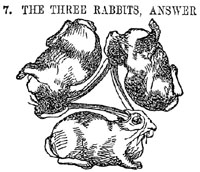
Left:from The Magician's Own Book, Puzzle No. 7 (1857, p. 269)
The Three Rabbits
What possible links can there be between Buddhist cave paintings in Dunhuang, China and Christian churches in the county of Devon in the UK, separated by 3000 miles, 500 years, and different cultures and religions? Yet an intriguing design of three rabbits chasing each other in a circle sharing three ears between them is found - in near identical form - in both places. Documenting and understanding this link is the subject of a project involving a diverse group of people from around the world.
The design occurs on the ceiling of at least 16 caves at Dunhuang, dating from the Sui (589-618) to the late Tang (848-907). The rabbits appear in the centre of a lotus flower but there seems to be no consistency in the direction in which they are running - some found chasing each other clockwise (as in cave 305) and others counter-clockwide (as in cave 407, shown on p. 1). As far as I have been able to ascertain, there has been no study of this design among the Dunhuang literature. An article by Ouyang Lin (reference below) refers to the design in caves 305, 397, 406, 407, 420 (all Sui dynasty) and 205 (high Tang) but only talks about its liveliness and does not consider any iconographic significance or its source.
Then there is the question of how the design travelled from China to Europe. The earliest examples in Europe are 13th century: in Germany, the Cistercian abbey bell at Kloster Haina; and, in France, a roof boss in Wissembourg and a sculptural fragment from a church at Corbigny. In Britain the design is found on tiles dating from about 1300 in Chester Cathedral, in Anglesey and in Long Crendon, Buckinghamshire. The roof bosses in the Devon churches date from the 15th century, and there are contemporary examples in France and Germany.
So far few examples have been found from sites and periods between Tang China and late medieval Europe. A pre-Islamic Mongol coin minted in 1281 was recently discovered in Northern Iran showing the three rabbits on one side and the collections of the Hermitage Museum in St. Petersburg include an 'oriental' silver vessel dated to about 1200. There are other examples of the design (also occuring as four rabbits) on Iranian plates at the Victoria and Albert Museum, London and on Maitreya's dohti at Alchi (although the animals are not easily identified in the latter, but they are in exactly the same format and share ears, see Goepper 1996, pp. 126-7).
In a recent article, Tom Greeves suggests that "it seems more than likely that textile was the medium through which the design was brought to Western Europe" (Greeves 2001, p. 60). the Pax Mongolia allowing an upsurge in trade, but evidence has yet to be found to support this hypothesis.
Peter Rasmussen and Wei Zhang of the Classical Chinese Puzzle Project have surveyed the Dunhuang cave paintings from published material and have identified sixteen caves in which the design occurs. Apart from those listed by Ouyang Lin, these are 127, 139, 144, 145, 147, 200, 237, 358, 383 and 468. During a recent visit to Dunhuang they were helped by Professor Peng Jinzhang and were able to see several caves on their list and confirm the existence of the design. They passed on the existing research about the design to Professor Peng who promised to find out what he could about research on the design at Dunhuang.
The members of the Three Hares Project are eager to hear from anyone who can provide any further information on this. Their details are given below.
I am indebted to David Singmaster who first brought my attention to the three rabbits and who has provided much information and the images for this article; to Wei Zhang and Peter Rasmussen who have passed on their details of their Dunhuang researches; to Sue Andrews for an informative conversation; and to Tom Greeves whose articles have provided much of the information given here.
Contacts
Three Hares Project
email: threehares@btinternet.com
Wei Zhang and Peter Rasmussen
Classical Chinese Puzzle Project,
1437 Milvia Street,
Berkeley,
CA 94709,
USA
email:wei@c2p2.org OR peter@c2p2.org
David Singmaster
SCISM,
South Bank University,
London,
SE1 0AA,
UK
email: zingmast@sbu.ac.uk
Further Reading
Goepper, Roger (Photography by Jaroslav Poncar), Alchi: Ladakh's Hidden Buddhist Sanctuary, The Sumtsek, Serindia Publications, London, 1996.
Greeves, Tom (member of the 'Three Hares Project'), 'The Three Hares - Dartmoor's Ancient Archetype', Dartmoor Magazine 61 (Winter 2000), pp. 8-11. —, 'Three Hares — a Medieval Mongol Mystery', Devon Today (April 2001), pp. 58-63.
Harte, Jeremy, 'The Tinners' Rabbits — A Dartmoor Mystery', Wisht Maen 3 (1994), pp. 7-19, 19.
Klein, Georges, 'Le Triquètre des Lièvres: a l'Eglise Protestante d'Ingwiller', Pays D'Alsace 161 (1992, 4), pp. 5-7.
Ouyang Lin, 'Dunhuang bihua zhong de lianhua tuan', Dunhuangxue jikan (1983.2), pp. 124-7.
Singmaster, David (details above) has compiled detailed documentation on the three rabbits, which is available on a CD along with images (contribution towards compiling and p&p required).
Ueckermann, E., 'Das Hasensymbol am Dom zu Padenborn, im Kloster Hardenhausen, in der Kathedralkirche St. Paulus in Münster und der Klosterkirche Haina', Zeitschrift für Jagdwissenschaft 41 (1995), pp. 285-91.
Exhibition
An exhibition of the Three Hares Project will be showing at the High Moorland Visitor Centre, Princetown, UK from Nov. 23- Dec. 5, 2001.
For more information contact: +44 (1) 1822 617004
Camel and Yak Hair on the Silk Road
M. L. Ryder
Members of the British Early Textile Study Group will remember a study day at the Victoria and Albert Museum, London, in November 1993, when Verity Wilson showed us examples of textiles from Central Asia (Xinjiang). These came from the 700 textile fragments brought back from the Silk Route by Sir Marc Aurel Stein between 1900 and 1916, which are housed in the Far Eastern Collection of the Museum where they are on loan from the Government of India (Wilson 1995). The present note summarises a preliminary microscopic investigation of fibres in samples of cloth fragments, balls of yarn, felt shoes and haired skin. The fibre diameter was measured in 33-yarn fibre or hair samples spread over four sites, Loulan in the east and Niya in the west, dated c.4th century, and Miran Fort in the east and Mazar-tagh in the west, dated c.8th century.
In general, hair identifications made by eye were not borne out by the microscopic study; e.g. a black and white hair sling cord, which appeared to be goat hair by eye, turned out to be yak hair. Over 60% of the samples were sheep's wool with one of goat hair, three of camel and five of yak. The plant fibres comprised one of flax and three of cotton. So far as I am aware this is the first investigation of hair and textile fibre remains from this area. It is therefore extremely interesting to find yak and camel hair in addition to goat hair and sheep's wool. The smallness of the sample of textiles, however, means that the quantitative statements given as follows may well have to be modified as more textiles from the collection are studied.
The yak is a bovine animal associated with Tibet and it is noteworthy that all the examples came from Miran Fort, to the south towards Tibet. In Europe, the traditional use of yak hair has been to make theatrical beards and the underwool has attracted attention in recent years as an adulterant of cashmere (goat underwool). The separate occurrence of yak outer hair and underwool in the Stein textiles indicates the harvesting of the underwool by combing the coat during the spring moult in the same way as cashmere is harvested from goats in China (Ryder 1993a). This in turn indicates domestic yak (bos grunniens), as opposed to wild yak (bos mutus) which still survive in the mountains of northern Tibet (Ryder 1993b).
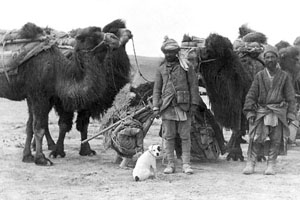
Left:Camels from the Lop Desert on Stein's 3rd Central Asian Expedition. The British Library: Photo. 392/28(746)
The camel hair examples came from Loulan and Mazar-tagh. This hair is most likely to have come from the domestic, two-humped Bactrian camel (camelus bactrianus) which is distributed to the north of Xinjiang and which would have provided the main transport of the Silk Route. Since the hair of the dromedary camel (camelus dromedarius) of the Middle East is short and coarse, that used in textiles comes mainly from the Bactrian camel, being collected during the moult of the animals during June and July. In contrast to the yak hair, only one of the three examples of camel hair showed evidence of the separation of the underwool from the outer hair, so the animals may not have been combed.
Sheep's wool was evenly distributed over all the sites. The earlier sites had only primitive and more hairy fleeces (hairy, hairy-medium and generalised-medium); the later sites had more highly developed fleeces (medium, semi-fine and true fine) previously associated mainly with Europe. The hairy-medium fleece (primitive hairy) was the first type to develop during the Bronze Age and the generalised-medium type (primitive woolly) also first appeared during the Bronze Age. Both were common in Europe until after the Middle Ages. The true hairy type first appeared in the Iron Age (Ryder 1983), as did the 'modern' medium, semi-fine and fine types, but they were found in only small numbers until after the Middle Ages (Ryder 1992). The nearest site to the Silk Route area that has been investigated is Pazyryk, lying due north in Siberia, and Ryder (1990) showed that here, around 400 BC, all fleece types except the true medium and the fine wool were represented.
The seed fibre cotton was found at all the sites except Mazar-tagh, whereas a bast fibre was found only at Mazar-tagh. It is surprising that this appeared to be flax rather than hemp, since hemp was domesticated in temperate Asia and was the main textile fibre of China for millennia from the Neolithic period onwards (Ryder 1993c). The mean fibre diameters of the cotton samples corresponded more with those of Indian, rather than Middle Eastern cotton.
From Archaeological Textiles Newsletter, No. 26, 20-21 (Spring 1998).
References
Ryder, M. L., Sheep and Man, Duckworth, London 1983.
— 'Wool remains from Scythian burials in Siberia', Oxford Journal of Archaeology 9 (1990), pp. 313-21.
— 'Skin and Wool Remains from Hallstatt', Mitteilungen der Anthropologische Gesellschaft in Wien 120 (1992), pp. 103-12.
— (1993a), 'The use of goat hair: an introductory historical review', Anthropozoologica 17 (1993), pp. 37-46.
— (1993b), 'Coats of Himalayan Ruminants Elucidated by Study of a "Yeti" Skin', The Linnean 9 (1993), pp. 21-6.
— (1993c), 'Probable hemp fibre in Bronze Age Scotland', Archaeological Textiles Newsletter 17 (1993), pp. 10-13.
Wilson, V. , 'Early Textiles from Central Asia: Approaches to Study with Reference to the Stein Loan Collection in the Victoria and Albert Museum, London', Textile History 26 (1995), pp. 23-52.
A Dash Across Asia
In keeping with the animal theme of this newsletter, we have decided to dedicate a page to the history of Sir Aurel Stein's various canine companions — all called Dash and all intrepid travellers with Stein on his Asian expeditions.
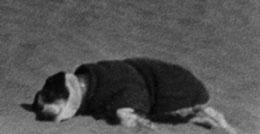
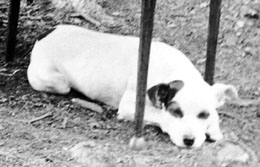
Left:Dash I at Niya on Stein's 1st Central Asian Expedition, January 1901. Published in Ancient Khotan fig.38, opp.p. 328
Right:Dash II The British Library: Photo. 392/23(12) detail
Dash I (1896-1902)
Dash I, Stein's first dog, was acquired in 1896 and accompanied Stein on his early travels, culminating in the 1st Central Asian Expedition. Known also by the Turki name Yolchi Beg — 'Sir Traveller' — given to him by Stein's servant Mirza, he is seen here at Niya in January 1901, wearing the Kashmiri coat specially made to protect him against the desert winter. He died in India in 1902 while Stein was in England.
Dash II (1904-18)
'Dash the Great', the dog against which all his successors were to be measured, was acquired by Stein in 1904 and travelled with him on the 2nd Central Asian Expedition. He returned to England with Stein in 1909 and lived in retirement in Oxford until 1918, when he was run over by a bus. He is shown here beneath Stein's desk in his camp at Mohand Marg near Srinagar in 1905.
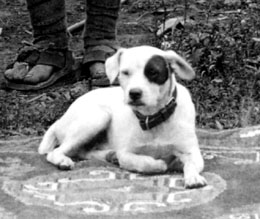
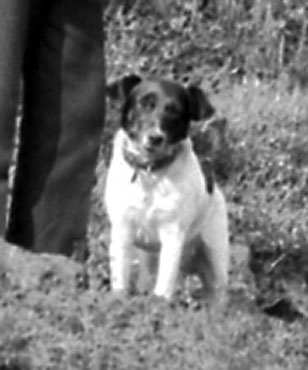
Left:Dash III The British Library: Photo. 392/29(10) detail
Right:Dash IV The British Library. Photo. 392/47(227) detail
Dash III (1912-19)
Acquired by Stein in 1912, Dash II's successor accompanied Stein on the 3rd Central Asian Expedition and is seen here at Jaglot in August 1913. He survived until 1919, when he was killed by a pack of dogs in Srinagar.
Dash IV (1921-25)
Acquired as a puppy in 1921, he was brought back to England by Stein in 1924, but died the following year. He is shown here with Stein in an Oxford garden in September 1925.
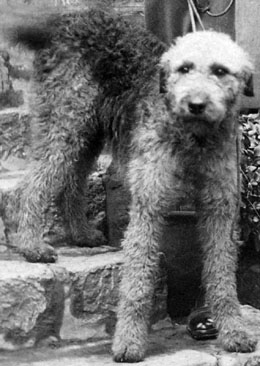
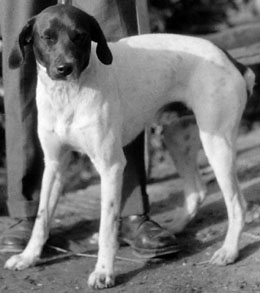
Left:Dash V The British Library. Photo. 392/33(4) detail
Right:Dash VI The British Library. Photo. 392/37(209) detail
Dash V (1927-30)
Acquired in 1927, Dash V was the only Dash who was not a fox terrier and is seen here at Srinagar in November 1928. He accompanied Stein on the 4th Central Asian Expedition, but died at Kashgar in 1930. Stein considered that he was perhaps overbred for the rigours of travelling.
Dash VI (1931-41)
Acquired in 1931 and considered by Stein 'a very promising reincarnation of Dash the Great', he travelled with Stein on his archaeological investigations in Iran and Iraq, and is here seen at Kerman, Iran in May 1932. He survived until 1941, when he was killed by a leopard near Mohand Marg.
Dash VII (1943-?)
Acquired 1943. Fate unknown.
Text by John Falconer and images, courtesy of Stein, prepared by Rachel Roberts.
More Dogs and Other Animals

More Dogs
The Saluqi
The origins of the hunting hound, known in the Arabic -speaking countries as Saluqi and in the Turkish/ Kurdish and Persian-speaking areas as Tazi, are obscure. Archaeological evidence from the 4th millennium in Iraq and Iran suggests that it was prevalent in Mesopotamia at that time but it remains unclear whether it originated there and was taken by soldiers or travellers along the Silk Road to China or whether it emerged from the steppes of Central Asia and spread west and south. Among the finest early representation of this hound in China is in a series of paintings from the tomb of Prince Zhanghuai (d. 684) near Xian, depicting falconers one of whom is also accompanied by a Saluqi/Tazi.
...and Other Animals Wild Camel Protection Foundation
The development of the Silk Road would not have been possible without the camel, but its domestication over 4,000 years ago and the destruction of its habitat more recently have threatened the wild camel. Estimated populations of wild Bactrian camels are now put at a maximum of 1200 and probably fewer than 800. The Wild Camel Protection Foundation was established in 1997 as a charitable trust to raise funds for the Lop Nur Nature Sanctuary in China to protect this dwindling population.
For further information contact:
John Hare, The Wild Camel Protection Foundation
School Farm, Benenden, TN17 4EU, UK
fax: +44 1580 240960
email: john@wildcamels.com
http://www.wildcamels.com/contact.htm
Sir Auriel Stein's Grave in Kabul
The following are photographs of Sir Aurel Stein's grave in Kabul, Afghanistan, taken by Victoria Finlay, who describes her visit below.

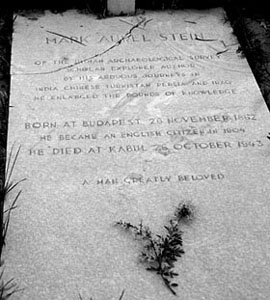
Inscription:Mark Aurel Stein of the Indian Archaeological Survey. Scholar, Explorer, Author. By his arduous journeys in India, Chinese Turkistan, Persia and Iraq he enlarged the bounds of knowledge. Born at Budapest 26 November 1862 he became an English citizen in 1904. He died at Kabul 26 October 1843. A man greatly beloved.
'We visited the Christian graveyard in April 2000. We couldn't find Aurel Stein at first, then — when we asked — the old guardian, Mr Rahimullah, pulled away some leaves to reveal his name on this stone, situated halfway between the graves of the Gurkhas and Scottish Highlanders killed in action in the Afghan-British war, and those of the hippy travellers 100 years later, their graves marked sometimes only with a nickname. Nobody had visited the cemetery for nearly six months, Mr Rahimullah told us. He used to be paid $15 US a month by the Italian Embassy, but now nobody pays him to keep the graves. He hadn't even wanted the job, he admitted, as we sat drinking green tea among the dandelion seeds in the long grass. He had been a shopkeeper nearby, and whenever the keeper of the cemetery went to his home in the mountains, he would leave the key. But the other man disappeared suddenly, and nobody knows what happened. That was in 1984. Although it was a Christian cemetery they hadn't had too much trouble, he said, considering the religious fervour that had spread round the city. Once the walls were hit by a rocket, but the UN rebuilt them; another time a crazed crowd rushed in to break the stones with guns. "I was frightened," he said. "But I kept coming here. There wasn't anyone else."'
Stein died shortly after arriving in Kabul, having longed to go there for many years. Any information about the current state of the grave will be gratefully received.
Victoria Finlay is currently researching a book on pigments (see IDP News 16, p. 7).
Conservation and Science
FT-Raman Microscopy

In Chapter 7 of her doctoral thesis, accepted earlier this year by University College, London, Lucia Burgio used Fourier-transform Raman Microscopy to investigate the dye on fragments of paper from the British Library Stein collection. Raman microscopy allows for the non-destructive analysis of materials in situ and is therefore particularly suited to analysing works of art. The advantage of FT-Raman over Raman microscopy with visible excitation is that , by making use of infrared excitation, the problem of fluorescence of materials nder analysis can frequently be overcome.
The experiments were carried out using a Bruker RFS 100/S FT-Raman microscope with 1064 nm excitation. Analysis of reference samples of Japanese kozo paper, some dyed with huangbo and some left untouched, gave reasonably good spectra.
Several dyed and non-dyed examples of manuscripts from the Stein collection were then analysed. The figure left shows the spectra of four fragments of different depths of colour.
This showed that FT-Raman microscopy is a useful technique as the huangbo dye was detected on all dyed fragments analysed from the Stein collection. Raman microscopy could also be used in the analysis of the paper fibres.
Lucia Borgia now works at the Victoria and Albert Museum. A book on Raman microscopy is planned in the British Library Studies in Conservation and Science series. Details will be given in a future issue.
Web Resources
The Central Eurasian Studies Society (CESS).
CESS is a new and rapidly growing scholarly association aimed at fostering communication and high standards of scholarship in the social sciences and humanities focused on Central Eurasia. Among its other activities, CESS holds an Annual Conference. For information on CESS membership, the Annual Meeting or CESR, visit: http://www.fas.harvard.edu/~cess/
The CentralAsia-L Announcement List for Central Asia Studies. CentralAsia-L distributes concise information about conferences, publications, jobs, grant opportunities, programs and other resources and opportunities in Central Asian studies. With ca. 3,000 subscribers worldwide, it is one of the most widely subscribed lists of its kind. For information, to subscribe, or to post information visit the webpage/archive at: http://www.fas.harvard.edu/~casww/CASWW_CentralAsia-L.html
Central Asian Studies World Wide website.
This web resource contains a wide range of information relevant to the study of Central Asia, ranging from recent dissertations, experts, scholars and institutions in Central Asian studies world wide, publications, Internet resources, and much more. Visit at: http://www.fas.harvard.edu/~casww/
Thanks to John Schoeberlein, Harvard/ICG/CESS for providing this information.
Exhibition Catalogues
Fabulous Creatures from the Desert Sands
— Central Asian Woolen Textiles from the Second Century BC to the Second Century AD
Emma C. Bunker, Judith H. Hofenk de Graaff, Dominik Keller, Regina Knaller,
Regula Schorta, Wang Bo, Xiao Xiaoyong
150 pages, 130 illustrations (60 colours),
2001 ISBN 3-905014-17-3
SFr. 85.--; in the exhibition SFr. 50.--
See also:
Emma C. Bunker, 'Fabulous Creatures from the Taklamakan Desert: Shanpula Textiles at the Abegg-Stiftung' Orientations 32,
6 (June 2001), pp. 60-62
Loulan Hanwen Jian Zhi Wenshu Jicheng
Hou Can and Yang Daixin Tiandi Publishing House,
Chengdu, 1999
3 vols., 670 pp, colour and b&w ills, Y2,986
This work contains detailed discussions of Chinese manuscripts on paper and wood discovered at all 14 sites of Loulan.
Professor Hou Can has led two archaeological expeditions to Loulan and has excavated many documents himself.Many more of the manuscripts are in the Stein collection at the British Library, and Stein's numbering has been retained in this work.
Monks and Merchants: Silk Road Treasures from Northwest China, 4th - 7th c.
Annette L. Juliano and Judith A. Lerner,
with contributions by some of the foremost specialists in the field
Asia Society, New York, 2001
352 pp., US$65.00 (hb)
Exhibitions
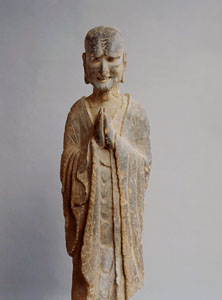
Fabulous Creatures from the Desert Sands:
Central Asian Textiles from 2000 Years Ago
Abegg-Stiftung, Riggisberg, Switzerland
April 28 - November 4, 2001
This year's special exhibition at the Abegg-Stiftung presents unique woolen tapestries, made some 2000 years ago in Central Asia and notable for their intense colors and mysterious designs. The objects in the exhibition were found during excavations at Shanpula, near Khotan and are presented here to the public for the first time. A catalogue is available.
For further details contact:
http://www.abegg-stiftung.ch/e/museum/sonderaus.html
Monks and Merchants: Silk Road Treasures from Northwest China, 4th - 7th c.
The Asia Society, New York, USA
October 13, 2001 - January 6, 2002
During this pivotal point in China's history, cultural exchange flourished along the Silk Road linking China with the Mediterranean, as missionaries and traders poured into China, proselytizing Buddhism and purveying exotic products. This section of the trade route, present-day Gansu and Ningxia, was an essential intermediary in this traffic of ideas and artifacts. With more than 120 works, Monks and Merchants explores how these foreign influences transformed Chinese society and culture.
For details contact: The Asia Society
Conferences
International Dunhuang Studies in the 21st Century
Conference in honour of Pan Zhonggui's 95th birthday
Chung Cheng University, Jiayi, Taiwan
2-4 November, 2001
For details contact:
Organizing Committee, International Dunhuang Studies in the 21st Century
Chinese Literature Department
National Chong Cheng University
160 Sanhsing Tsun, Minhsiung
Chiayi Hsien, TAIWAN
Tel: +886 5 2720411
Fax: +886 5 2720493 v
email: chlacc@ccunix.ccu.edu.tw
Current Research on Sasanian Archaeology and History University of Durham, UK
3-4 November, 2001
Intended as an informal meeting of archaeologists and historians engaged in research of aspects of the Sasanian empire and its surrounding regions, several iranian scholars are also expected to attend and report on recent excavations in Iran.
For further details contact:
Dr D. Kennet
Dept. of Archaeology
University of Durham
South Road, Durham, DH1 3LE, UK
Fax: +44 191 374 3619 v
email:sasanian.conference@durham.ac.uk
http://www.dur.ac.uk/~drk0225/Conference.htm
Nomads, Traders, and Holy Men Along China's Silk Road Asia Society, New York, USA
9-10 November, 2001
Speakers include Wu Hung, University of Chicago; Jessica Rawson, Oxford University; Victor Mair, University of Pennsylvania; Emma Bunker, Denver Art Museum; Richard Frye, Harvard University; An Jiayao, Chinese Academy of Social Sciences; Theodore Levin, Dartmouth College; Angela Sheng; Neville Agnew, The Getty Conservation Institute
For details contact The Asia Society:
725 Park Avenue
New York, NY 10021, USA
Tel: +1 212-327-9276
http://www.asiasociety.org
Buddhism on the Silk Road
American Academy of Religion
Denver, CO. USA
17-20 November, 2001
This is planned as a session during the annual meeting of the American Academy of Religion annual meeting. Send short proposals of abstracts to Mariko Walter at:
email: mwalter@mailbox.une.edu
Eurasian Steppes in Prehistory and the Middle Ages
The State Hermitage Museum
St. Petersburg, Russia
March 2002
This conference commemorates the centenary of the birth of the Academician Mikhael Graiznov. Abstracts of 1500 words are required by 1 November.
For details contact:
M. N. Pshenitsyna
Institute of the History of Material Culture
Dvortsovaya naberezhnaya 18
St. Petersburg 191186
Russia
Fax: +7 812 311 6271
email: nikbok@infopro.spu.su OR admin@archae.ru
Turfan Revisited:
The First Century of Research Into the Arts and Cultures of the Silk Road
Berlin, Germany
8-15 September, 2002
This conference will conincide with a major international exhibition at the Museum of Indian Art in Berlin-Dahlem. Details of both will be given in a future issue.
For details contact:
Professor Dr Werner Sundermann
Akademienvorhaben Turfanforschung Berlin-Brandenburgishce
Akademie der Wissenschaften
Unter den Linden 6
D-10117 Berlin
Germany
Tel: +49 30 20370 472
Fax: +49 30 20370 467
email: sundermann@bbaw.de
Project News
New Staff
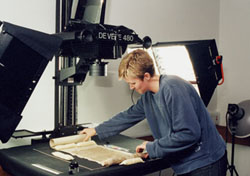
Left:Rachel Roberts photographing a Dunhuang manuscript in the IDP Digitisation Studio. Photograph by Elizabeth Hunter.
We are delighted to welcome six new members of staff to the Project as the result of the generous grant to the British Library by the Andrew W. Mellon Foundation (see previous newsletter).
Kate Hampson has joined as Project Administrator and any queries about the Project or the newsletter mailing should be directed to her.
The photographers Jonathan Jackson, Rachel Roberts and Caroline Smith started in May/June. They are using Photophase Phase One digital camera backs to produce high quality digital images of the Stein 2nd expedition scrolls from Dunhuang, all of which are being entered on to the IDP Interactive Web Database and will also form part of the Mellon International Dunhuang Archive.

Right:Eva Del Rey at one of the new Photoshop workstations in the IDP Digitisation Studio. Photograph by Elizabeth Hunter.
Eva Del Rey and Vic Swift are carrying out the necessary colour correction and manipulation of the images using Photoshop, and stitching the images together to form single images of the long scrolls.
Documentation is being prepared for all the work being carried out in the IDP Digitisation Studio and will be available shortly in hard copy from IDP and on the web. Feedback is welcome. Caroline Smith is also working on web pages showing the work of the studio, which will contain video footage by Eva Del Rey. These will be mounted with the relaunch of the web site scheduled for early next year.
Doug Osto and Sandy Ryan also joined the team as part-time image manipulators working on Tibetan woodslips and Stein 3rd expedition Chinese material respectively. Catherine Till, a long-term member of the IDP staff, is now also working on image manipulation of the Tangut fragments.
National Library of China
Three staff are working on the project at the National Library of China thanks to a generous grant from the Sino-British Fellowship Trust (details in previous newsletter). A room in the National Library has been devoted to the project and, in May and June this year, Colin Chinnery, as China Project Manager, went out to coordinate the purchase of computer equipment and supervise its deployment.
Mr Lin Shitian and Ms Wang Ziyi are now working on the project, along with some help from Ms Chen Hongyan. Mr Lin is a Buddhist scholar with a BA from Lanzhou University and the author of many articles and and books on Buddhism and Sven Hedin's expeditions. Ms Wang is an assistant librarian with a certificate in Library Management. Ms Chen, who is Vice Director of the Rare Books Department, graduated from Peking University and has also published widely.
Work on digitising the collection will start in November this year and reports on progress will be carried in future issues.

Dr Ksenia Kepping with Dr Frances Wood, Head of the Chinese Section at the British Library. Photograph by Elizabeth Hunter.
Tocharian Digitisation Project
A collaborative project between IDP, the Tocharian Database/Universitat Frankfurt (TITUS) and Joulian Co. Ltd. was agreed earlier this year and work started in June. The aim of the first stage of the project is to digitise the 800 Tocharian manuscripts in the British Library collections and to add them to the TITUS and IDP databases. Work has started on this and will be completed by the end of this year.
Following this, work will start on cataloguing the fragments. This is expected to take until 2004 and will be carried out by Mr Tamai. the catalogue data will also be available on TITUS and IDP.
Tangut Cataloguing
Dr Ksenia Kepping finished her work on cataloguing a portion of the Tangut manuscripts and printed material at the British Library. The next issue of the newsletter will be devoted to Tangut studies and will include an article by Dr. Kepping.
The Collections of Sir Aurel Stein in the Library of the Hungarian Academy of Sciences
Funding has been secured for a third and final year of this collaborative project. A Stein day will be held in the British Museum in March 2002 to report the results of the project and the publication of an English language catalogue of the Stein collections in Budapest will follow shortly thereafter.
